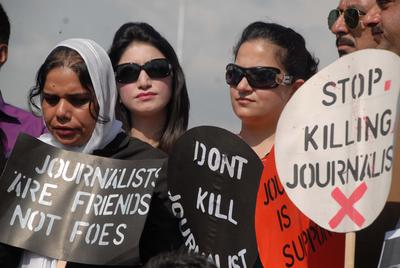The methods are numerous: abduction, murder, physical torture, beating to death, throat-slitting, suicide attack and bombs. And it’s not just militants, insurgents, separatists, gangsters and drug traffickers whom journalists have to fear: state sponsored actors, including intelligence agencies, also pose a threat.
Though the exact data regarding the death toll of journalists is not available, the international monitoring group Committee to Protect Journalists (CPJ) has done extensive study. Obtaining reliable data on journalist deaths is difficult; however, the CPJsays that from 1992 to January this year, 78 journalists or media workers have been killed in Pakistan. Of these, 54 have confirmed motives. The overall number includes six media support workers, including translators, drivers, guards, fixers and administrative workers. Among the victims, about 56 per cent worked in print media and 46 per cent worked in television. Geographically, 21 have been killed in Sindh, 19 each in Balochistan and Khyber Pakhtunkhwa, ten in Punjab and nine in Federally Administered Tribal Areas.
The CPJ estimates that Pakistan was the most dangerous place on earth for journalists in 2010 and 2011. The World Press Freedom Index ranks Pakistan 158th out of 180 countries: it scores just above Somalia, Rwanda and Egypt.
What has led to this intolerable situation?
One reason for the continued atrocities is simple: impunity. Despite repeated demands from Pakistani and international journalist organisations, not one of the crimes has been put to a credible trial. According to Amnesty International’s 2014 Report titled A bullet has been chosen for you: Attacks on journalists in Pakistan, in only two such cases in the past two decades were the suspected perpetrators convicted by the courts. In 2002, four men were convicted for the murder of American journalist Daniel Pearl earlier that year — but this was only after Pakistan faced significant international pressure, particularly from the United States government. And on 1 March 2014, six men were convicted of the murder of Wali Khan Babar.
The failure of the Pakistani authorities to prosecute perpetrators effectively sends a signal that any individual or group with the means and intent can get away with murder. It is also a sign that the Pakistani state is effectively powerless. As Sherry Ricciardi notes in a report for the Center for International Media Assistance, in 2002, ‘President Pervez Musharraf took few steps to free up the broadcast laws and set in motion a media market boom that revolutionized how news was reported’.
But nothing much has changed in terms of providing security to the sector. On 19 March, the Ministry of Information, Broadcasting and National Heritage stated that Prime Minister Nawaz Sharif is ‘taking personal interest in ensuring all measure for the welfare and protection of the journalists and has announced to constitute a commission comprising media persons, public figures and government representatives which will purpose measures to be adopted by the government to protect journalists in the field and ensure their well being’.
Apart from terrorists, the media in Pakistan also suffers from indirect political pressure. Tellingly, although Pakistan is a party to the International Covenant on Civil and Political Rights, of which Article 19 protects the right to freedom of expression, there are a number of legislative and regulatory mechanisms that directly and indirectly affect the media. For example, under the Pakistan Electronic Media Regulatory Authority (PEMRA) 2012, no programme shall be aired which contains aspersions against the Judiciary and the integrity of Pakistani Armed Forces. The reason for this is that when the ‘liberalisation’ of ownership in media took place, it did so under military rule in an atmosphere of tight control over media freedom. The government also forbade private radio stations from producing their own news programmes, forcing them to relay news bulletins from the state-owned Pakistan Broadcasting Corporation instead.
In a society so obsessed with ‘righteous’ conduct, journalists have come to fear violence just for doing their job. This is unacceptable, and Pakistani authorities must realise that the murder of journalists is a worrying sign of the government’s impotency.
Sanchita Bhattacharya is a New Delhi based researcher working on Political Islam in the Indian Sub-continent. Currently she is working as Research Associate in the Institute for Conflict Management.

